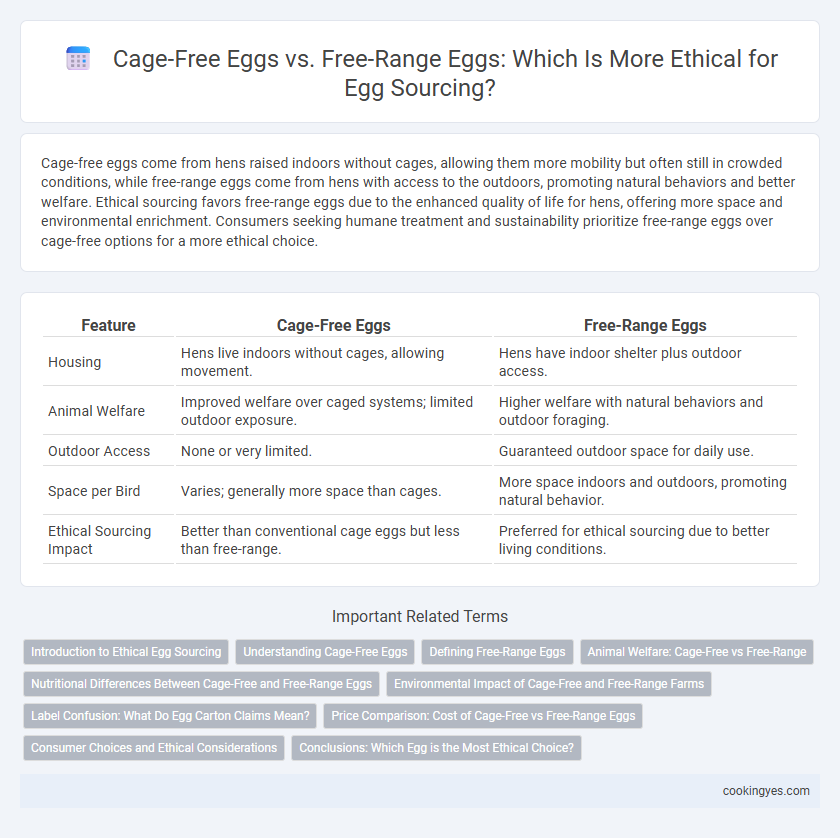Cage-free eggs come from hens raised indoors without cages, allowing them more mobility but often still in crowded conditions, while free-range eggs come from hens with access to the outdoors, promoting natural behaviors and better welfare. Ethical sourcing favors free-range eggs due to the enhanced quality of life for hens, offering more space and environmental enrichment. Consumers seeking humane treatment and sustainability prioritize free-range eggs over cage-free options for a more ethical choice.
Table of Comparison
| Feature | Cage-Free Eggs | Free-Range Eggs |
|---|---|---|
| Housing | Hens live indoors without cages, allowing movement. | Hens have indoor shelter plus outdoor access. |
| Animal Welfare | Improved welfare over caged systems; limited outdoor exposure. | Higher welfare with natural behaviors and outdoor foraging. |
| Outdoor Access | None or very limited. | Guaranteed outdoor space for daily use. |
| Space per Bird | Varies; generally more space than cages. | More space indoors and outdoors, promoting natural behavior. |
| Ethical Sourcing Impact | Better than conventional cage eggs but less than free-range. | Preferred for ethical sourcing due to better living conditions. |
Introduction to Ethical Egg Sourcing
Cage-free eggs come from hens that are allowed to roam freely within an enclosed space, improving their welfare compared to conventional caged systems. Free-range eggs refer to hens that have access to the outdoors, providing better natural behaviors and enhanced living conditions. Ethical egg sourcing emphasizes animal welfare, environmental sustainability, and transparency in farming practices to ensure humane treatment and responsible production.
Understanding Cage-Free Eggs
Cage-free eggs come from hens that are raised indoors with the freedom to walk, spread their wings, and lay eggs in nests, contrasting with conventional caged systems that restrict movement. These hens often have access to perches and nesting boxes, improving their welfare by allowing natural behaviors, but without guaranteed outdoor access unlike free-range hens. Understanding cage-free eggs highlights critical ethical sourcing decisions focusing on animal welfare within controlled environments.
Defining Free-Range Eggs
Free-range eggs come from hens that have continuous daytime outdoor access, allowing natural behaviors such as foraging and dust bathing, which promotes better animal welfare compared to cage-free systems. These hens typically enjoy larger living spaces and more natural light, contributing to healthier, less stressed birds, making free-range eggs a preferred choice for ethically conscious consumers. Free-range certification standards vary by region but consistently emphasize outdoor access and improved living conditions beyond conventional cage or cage-free environments.
Animal Welfare: Cage-Free vs Free-Range
Cage-free eggs come from hens that are allowed to roam freely within an enclosed barn, promoting natural behaviors like perching and nesting, which enhances animal welfare compared to conventional caged systems. Free-range eggs provide hens with outdoor access in addition to indoor space, further improving welfare by enabling behaviors such as foraging, dust bathing, and exposure to natural sunlight. Ethical sourcing often favors free-range eggs for offering superior living conditions that align with higher animal welfare standards.
Nutritional Differences Between Cage-Free and Free-Range Eggs
Cage-free and free-range eggs differ primarily in hens' living conditions, which impact their nutritional profiles. Free-range eggs often contain higher levels of omega-3 fatty acids and vitamin D due to hens' access to outdoor environments and natural diets. Cage-free eggs provide improved welfare compared to caged systems but may have slightly lower nutrient density compared to free-range counterparts.
Environmental Impact of Cage-Free and Free-Range Farms
Cage-free eggs typically come from hens that can move freely within a barn environment but lack outdoor access, resulting in moderate environmental impact due to controlled waste management and energy use. Free-range eggs involve hens with outdoor access, which can enhance soil health and biodiversity through natural foraging but may also increase land use and greenhouse gas emissions from dispersed manure. Ethically sourced eggs from free-range systems often promote better animal welfare while presenting a more complex environmental footprint compared to cage-free operations.
Label Confusion: What Do Egg Carton Claims Mean?
Cage-free eggs come from hens that live indoors without traditional cages but may have limited space, whereas free-range eggs indicate hens have some outdoor access, though the duration and quality vary widely. Labels like "cage-free" and "free-range" lack standardized enforcement, leading to significant consumer confusion and difficulty verifying ethical sourcing claims. Understanding these definitions is crucial for choosing eggs that align with animal welfare values and transparency in farming practices.
Price Comparison: Cost of Cage-Free vs Free-Range Eggs
Cage-free eggs typically cost less than free-range eggs due to lower land and management requirements. Free-range eggs command a higher price because hens have outdoor access, increasing operational costs for farmers. Consumers often pay a premium for free-range eggs based on perceived animal welfare benefits and production scale.
Consumer Choices and Ethical Considerations
Cage-free eggs come from hens that are raised indoors without cages, allowing them to move freely within a barn, while free-range eggs are sourced from hens that have access to outdoor spaces, promoting natural behaviors and better welfare. Ethical considerations in consumer choices often prioritize free-range eggs for their enhanced space and natural environment, which align with humane farming practices and animal well-being. Consumers seeking ethical sourcing weigh factors such as animal welfare standards, environmental impact, and farm transparency when choosing between cage-free and free-range eggs.
Conclusions: Which Egg is the Most Ethical Choice?
Cage-free eggs offer chickens more space and freedom of movement compared to conventional caged systems but still lack outdoor access, limiting natural behaviors. Free-range eggs provide birds access to outdoor environments, promoting better welfare through natural foraging and exercise, making them a more ethical option. Choosing free-range eggs supports higher animal welfare standards and aligns closely with ethical sourcing principles.
Cage-free eggs vs Free-range eggs for ethical sourcing Infographic

 cookingyes.com
cookingyes.com